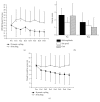High-Cadence Cycling Promotes Sustained Improvement in Bradykinesia, Rigidity, and Mobility in Individuals with Mild-Moderate Parkinson's Disease
- PMID: 30944720
- PMCID: PMC6421744
- DOI: 10.1155/2019/4076862
High-Cadence Cycling Promotes Sustained Improvement in Bradykinesia, Rigidity, and Mobility in Individuals with Mild-Moderate Parkinson's Disease
Abstract
Introduction: Exercise has been shown to be an important adjunct therapy to medication in Parkinson's disease (PD). However, the optimal type, frequency, and intensity of exercise or physiotherapy are still being debated. An important part of understanding the optimal frequency is to examine how acute bouts of exercise affect motor function and mobility in this population. The purpose of this study is to assess if six bouts of high-cadence cycling improves motor function and mobility in individuals with PD.
Methods: Sixteen subjects with mild-moderate idiopathic PD were randomized into either a high-cadence cycling or a control (stretching) group. High-cadence cycling was completed on a custom motorized recumbent bicycle at a high cadence between 75 and 85 rpm. Cycling and stretching sessions were separated by 1 day of rest and took place over a 15-day period. Motor function and mobility were assessed after every cycling/stretching bout using the UPDRS Motor III scale, Kinesia ONE, and Timed up and Go (TUG).
Results: Six bouts of high-cadence cycling improved UPDRS scores (2.5 pts, P=0.002), hand movement amplitude (P=0.013), rapid alternating hand movement speed (P=0.003), gait (P=0.012), and TUG time (1.17 s, P=0.002) from baseline testing to end of treatment. The control group showed no improvements.
Conclusions: These findings suggest that they are both acute and sustained improvements in motor function and mobility after high-cadence cycling. Future research should examine how exercise type, frequency, and intensity can be optimized for each individual.
Figures


References
LinkOut - more resources
Full Text Sources
Medical

